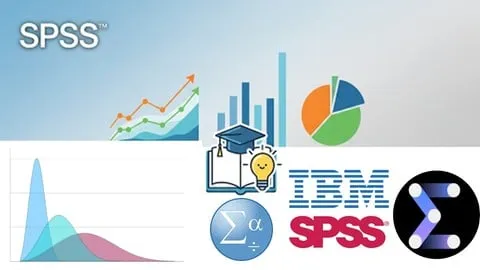Data Analysis With Spss Using Menu Bar And Spss Syntax
Published 8/2025
MP4 | Video: h264, 1920x1080 | Audio: AAC, 44.1 KHz
Language: English | Size: 3.11 GB | Duration: 4h 48m
Published 8/2025
MP4 | Video: h264, 1920x1080 | Audio: AAC, 44.1 KHz
Language: English | Size: 3.11 GB | Duration: 4h 48m
From Data Entry and Data Analysis to Interpretation: A Beginner's Guide to SPSS | Application of SPSS Syntax file
What you'll learn
Beginners can easily learn data analysis in SPSS
Import data from external sources, such as Microsoft Excel.
Calculate and interpret descriptive statistics for both continuous and categorical variables.
Data analysis for a manuscript, report, or a Master's or Ph.D. thesis.
Requirements
No prior experience with SPSS or statistics is required
Access to the SPSS statistical software
A good mindset to have when learning SPSS
Description
Struggling with data analysis for your manuscript, report, or thesis? Feeling overwhelmed by statistical software? This course is your complete, beginner-friendly guide to mastering the fundamentals of data analysis using SPSS. We will take you on a practical journey from Data Entry and Data Analysis to Interpretation, empowering you to confidently manage your data and present your findings.This course skips the complex jargon and focuses on a step-by-step, hands-on approach. By the end, you won't just know how to click buttons—you'll understand what you're doing and why you're doing it.What you will learn in this course:Navigate the SPSS interface with confidence and ease.Enter and import your own data, and prepare it for analysis by defining variables and assigning labels.Clean and manage your data, including handling missing values and computing new variables.Run and interpret essential descriptive statistics such as frequencies, means, and standard deviations.Create compelling charts and graphs to visualize your data for reports and presentations.Perform and interpret key statistical tests like the independent-samples t-test and the chi-square test.Draw meaningful conclusions from your results and effectively communicate your findings.Who is this course for?New Researchers in public health, marketing, or social sciences who need to analyze data for their studies and projects.Master's or Ph.D. Students working on a thesis or dissertation who need to perform data analysis.Professionals in various fields (e.g., social sciences, education, business) who need to analyze data from surveys, reports, or studies.Are there any prerequisites?No prior experience with SPSS or statistics is required.Access to the SPSS statistical software.You should have your research question and data collected and ready for analysis.If you are a beginner looking to transform raw data into clear, compelling results for your academic or professional work, this is the course for you.
Overview
Section 1: Introduction to SPSS
Lecture 1 Getting Started with SPSS
Lecture 2 Creating a Database in SPSS
Lecture 3 Data Measurement in SPSS | Nominal, Ordinal, and Scale
Lecture 4 An Introduction to SPSS Syntax
Section 2: SPSS Data Management | Part 1 - Data Import from Excel, CSV, Stata, Labelling
Lecture 5 Import Data from Excel to SPSS
Lecture 6 How to Import Data from a CSV File into SPSS
Lecture 7 Import Data from Stata to SPSS (SPSS version>29)
Lecture 8 Define variable label in SPSS using syntax
Lecture 9 Define Value Labels for Categorical Variables in SPSS using Syntax
Section 3: SPSS Data Management | Part 2 - Variables keep, delete, arrange, Transformation
Lecture 10 Variable Reordering & Re-arranging: Organizing Your SPSS Dataset
Lecture 11 Sorting Cases: Organizing Your Dataset by Row in SPSS
Lecture 12 Deleting & Keeping Variables: Cleaning Your Dataset in SPSS
Lecture 13 Compute New Variable: Creating New Variables in SPSS
Lecture 14 Recode Variables: Simplifying and Grouping Data in SPSS (Menu & Syntax)
Lecture 15 Advanced Recoding: Using Logical Operators (IF statements) in SPSS
Lecture 16 Categorical to Categorical Transformation with Logical Operators in SPSS
Lecture 17 How to Create Dummy Variables in SPSS (Applicable for upper version)
Lecture 18 Dummy Variables: Creating Binary Variables with the COMPUTE Method
Section 4: Visualizing Your Data with Graphs
Lecture 19 Creating Histograms in SPSS (Menu & Syntax)
Lecture 20 Boxplots: Visualizing Data Distribution and Outliers in SPSS ?
Section 5: Descriptive Statistics in SPSS ?
Lecture 21 Frequency Tables: Analyzing Categorical Data in SPSS ?
Lecture 22 Mean, Standard Deviation, & Variance: Summarizing Continuous Data in SPSS ?
Lecture 23 Another option for calculating Mean, Standard Deviation
Lecture 24 Median & Quartiles: Measures of Position in SPSS ?
Lecture 25 Cross-Tabulation: Analyzing Relationships Between Categorical Variables ?
Lecture 26 Comparing Means by Group: Analyzing Continuous Data Across Categories in SPSS ?
Lecture 27 Creating Publication-Ready Tables: From SPSS Output to Report ?
Section 6: Inferential Statistics in SPSS ?
Lecture 28 T-Test: Comparing Means Between Two Groups in SPSS (Menu & Syntax) ?
Lecture 29 One-Way ANOVA: Comparing Means Among Multiple Groups in SPSS ?
Section 7: Regression Analysis in SPSS ?
Lecture 30 Correlation: Relationships Between Variables in SPSS ?
Lecture 31 Linear Regression: Predicting a Continuous Outcome in SPSS ?
Lecture 32 Linear Regression Diagnostics & Interpretation: Validating Your Model's Findings
Lecture 33 Simple Logistic Regression: Predicting a Binary Outcome in SPSS ✅
Lecture 34 Logistic Regression: Using Categorical Predictors in SPSS ?
Lecture 35 Sample Table for Logistic Regression Findings for a Manuscript/Report
Lecture 36 Creating a Table for Logistic Regression Findings for a Manuscript/Report ?
New Researchers in public health, marketing, or social sciences who need to analyze data for their studies and projects.,Master's or Ph.D. Students who are working on a thesis or dissertation and need to perform data analysis for their research.,Professionals in various fields such as social sciences, health sciences, education, or business who need to analyze data from surveys, reports, or studies for their work.



